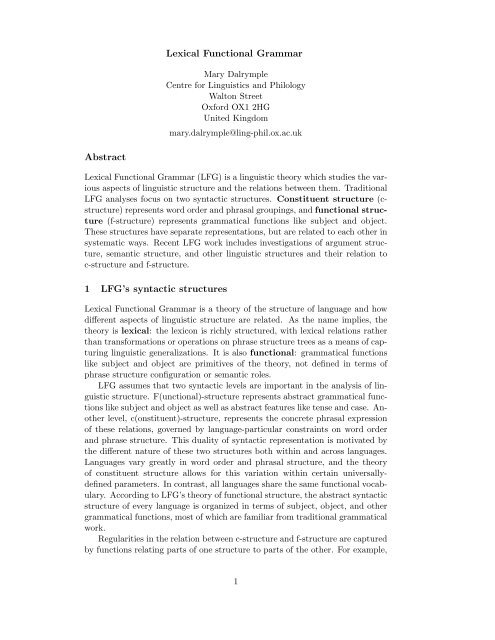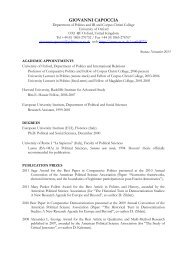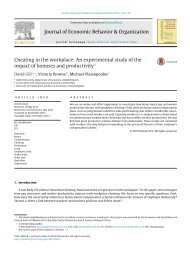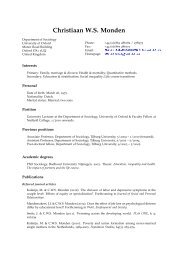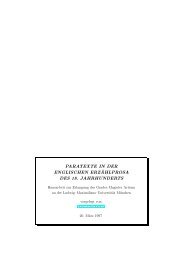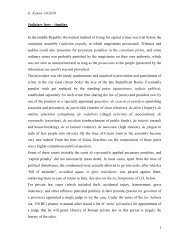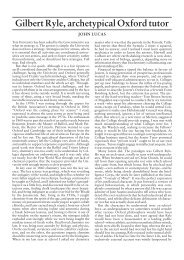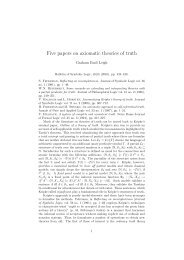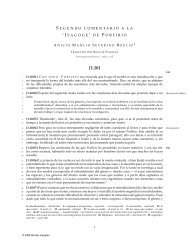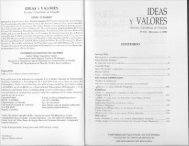Lexical Functional Grammar - Personal Pages Index
Lexical Functional Grammar - Personal Pages Index
Lexical Functional Grammar - Personal Pages Index
Create successful ePaper yourself
Turn your PDF publications into a flip-book with our unique Google optimized e-Paper software.
<strong>Lexical</strong> <strong>Functional</strong> <strong>Grammar</strong><br />
Mary Dalrymple<br />
Centre for Linguistics and Philology<br />
Walton Street<br />
Oxford OX1 2HG<br />
United Kingdom<br />
mary.dalrymple@ling-phil.ox.ac.uk<br />
Abstract<br />
<strong>Lexical</strong> <strong>Functional</strong> <strong>Grammar</strong> (LFG) is a linguistic theory which studies the various<br />
aspects of linguistic structure and the relations between them. Traditional<br />
LFG analyses focus on two syntactic structures. Constituent structure (cstructure)<br />
represents word orderand phrasal groupings, andfunctional structure<br />
(f-structure) represents grammatical functions like subject and object.<br />
These structures have separate representations, but are related to each other in<br />
systematic ways. Recent LFG work includes investigations of argument structure,<br />
semantic structure, and other linguistic structures and their relation to<br />
c-structure and f-structure.<br />
1 LFG’s syntactic structures<br />
<strong>Lexical</strong> <strong>Functional</strong> <strong>Grammar</strong> is a theory of the structure of language and how<br />
different aspects of linguistic structure are related. As the name implies, the<br />
theory is lexical: the lexicon is richly structured, with lexical relations rather<br />
than transformations or operations on phrase structure trees as a means of capturing<br />
linguistic generalizations. It is also functional: grammatical functions<br />
like subject and object are primitives of the theory, not defined in terms of<br />
phrase structure configuration or semantic roles.<br />
LFG assumes that two syntactic levels are important in the analysis of linguistic<br />
structure. F(unctional)-structure represents abstract grammatical functions<br />
like subjectand object as well as abstract features like tense and case. Another<br />
level, c(onstituent)-structure, represents the concrete phrasal expression<br />
of these relations, governed by language-particular constraints on word order<br />
and phrase structure. This duality of syntactic representation is motivated by<br />
the different nature of these two structures both within and across languages.<br />
Languages vary greatly in word order and phrasal structure, and the theory<br />
of constituent structure allows for this variation within certain universallydefined<br />
parameters. In contrast, all languages share the same functional vocabulary.<br />
According to LFG’s theory of functional structure, the abstract syntactic<br />
structure of every language is organized in terms of subject, object, and other<br />
grammatical functions, most of which are familiar from traditional grammatical<br />
work.<br />
Regularities in the relation between c-structure and f-structure are captured<br />
by functions relating parts of one structure to parts of the other. For example,<br />
1
the subject phrase in the c-structure tree is related to the subject f-structure<br />
by means of a function which relates nodes of the c-structure tree to parts of<br />
the f-structure for a sentence. Relations between c-structure, f-structure, and<br />
other linguistic levels have also been explored and defined in terms of functional<br />
mappings from subparts of one structure to the correspondingsubparts of other<br />
structures.<br />
The overall formal structure and basic linguistic assumptions of the theory<br />
havechangedverylittlesinceitsdevelopment inthelate1970s byJoanBresnan,<br />
a linguist trained at the Massachusetts Institute of Technology, and Ronald<br />
M. Kaplan, a psycholinguist and computational linguist trained at Harvard<br />
University. Bresnan (1982) is a collection of influential early papers in LFG;<br />
recent works providing an overview or introduction to LFG include Dalrymple<br />
et al. (1995), Bresnan (2001), Dalrymple (2001), Falk (2001), and Kroeger<br />
(2004).<br />
2 Constituent structure<br />
Languages vary greatly in the basic phrasal expression of even simple sentences.<br />
Basic word order can be verb-initial (Malagasy), verb-final (Japanese), or verbmedial<br />
(English). Word order correlates with grammatical function in some<br />
languages, such as English, in which the subject and other arguments appear<br />
in particular phrase structure positions. In other languages, word order is<br />
more free, and grammatical functions are identified by casemarking or agreement<br />
rather than phrasal configuration: in many languages, there is no specific<br />
phrasal position wherethe subject or object must always appear. Requirements<br />
for phrasal groupings also differ across languages. In English, for example, a<br />
nounandanyadjectives that modifyit mustappeartogether andformaphrasal<br />
unit. In many other languages, including Latin, this is not necessary, and a<br />
noun can be separated from its modifying adjectives in the sentence. LFG’s<br />
constituent structure represents word order and phrasal constituenthood.<br />
2.1 Constituent structure representation<br />
Like many other linguistic theories, LFG represents word order and phrasal<br />
groupings by means of phrase structure trees, also called constituent structures<br />
(see Constituent structure) or c-structures. The c-structure for an English<br />
sentence like David is sleeping is:<br />
2
(1) David is sleeping.<br />
IP<br />
NP<br />
I ′<br />
N ′<br />
I<br />
VP<br />
N<br />
David<br />
is<br />
V ′<br />
V<br />
sleeping<br />
C-structure trees contain two sorts of categories. Categories such as N (noun)<br />
and V (verb), familiar from traditional grammatical analysis, are called lexical<br />
categories. MostLFGanalyses assumeat least thelexical categories N(noun),<br />
A (adjective), V (verb), Adv (adverb), and P (preposition), though more or<br />
fewer categories may be relevant for a particular language. Most languages<br />
also make use of a set of functional categories, including I (for Inflection),<br />
C (for Complementizer), and D (for Determiner). <strong>Functional</strong> categories play<br />
an organizing role in the syntax, and are either associated with closed-class<br />
categories such as complementizers, or are filled with subtypes of particular<br />
lexical categories.<br />
Constituent structure is organized according to X-bar theory (see X-bar<br />
theory), which assumes that phrases are internally headed and therefore endocentric:<br />
a phrase and its head have the same category, but a different bar<br />
level. For example, the basic lexical category N is the head of the single bar<br />
level category N ′ (“N-bar”), which in turn is the head of the two-bar-level category<br />
N ′′ (“N-double-bar”). Similarly, the basic functional category I is the<br />
head of I ′ , which heads I ′′ . Many LFG analyses assume that N ′′ and I ′′ are<br />
maximal phrases, meaning that there is no category N ′′′ or I ′′′ for the doublebar-level<br />
category to head. Thus, as maximal phrases, the categories N ′′ and<br />
I ′′ are usually written as NP (noun phrase) and IP (the category assigned to<br />
a sentence like David is sleeping). Nonprojecting categories are also assumed<br />
(Toivonen, 2003); these are lexical categories that are not heads of phrases, but<br />
appear on their own, adjoined to heads. For example, verbal particles (words<br />
corresponding to the particle up in a sentence like I woke up the baby) in some<br />
Germanic languages are nonprojecting words, typically prepositions, adjoined<br />
to the verb.<br />
Not all phrases are endocentric. LFG assumes a single exocentric, nonheaded<br />
category, the category S, which does not obey the constraints of X-bar<br />
theory. Not all languages make use of this phrase; it plays no role in the syntax<br />
of English, for example. In languages that make use of this phrase, it behaves<br />
as a maximal phrase, but it has no c-structure head, and it can dominate<br />
phrases of any category or bar level. As we will see below, it does not obey<br />
thegeneralizations whichconstrain therelation between endocentricc-structure<br />
categories and f-structure, and so is often motivated in languages with very free<br />
word order, in which morphological information rather than phrase structure<br />
3
position determines the functional role of a phrase.<br />
A phrase can dominate other constituents besides its head. LFG does not<br />
require phrase structure trees to be binary branching, and so there can be more<br />
than two daughters of any node in a c-structure tree. The nonhead daughter<br />
of a maximal phrase is called its specifier, and the nonhead sisters of a lexical<br />
category are its complements. This is shown schematically in (2):<br />
(2) XP<br />
YP<br />
X ′<br />
(specifier of XP)<br />
X<br />
(head)<br />
ZP ...<br />
(complements of X)<br />
As shown in (1), a verbal category, often an auxiliary, appears in I. The<br />
complement of I is either VP, as in (1), or, in languages which make use of<br />
it, the exocentric category S. Not all languages make use of the functional<br />
category C and the phrases it heads, C ′ and CP. When a language makes use of<br />
this category, complementizers or verbs can appear in C, and the complement<br />
of C is IP or S. The functional category D, filled by a determiner, is also often<br />
assumed: the complement of D is NP. In the following, we will not assume DP,<br />
which will mean that the category of a phrase like the boy is NP. However, there<br />
is no general agreement of the status of such phrases in LFG: according to some<br />
analyses, the boy is a DP rather than an NP in at least some languages.<br />
Unlike many theories, LFG assumes that daughters of all phrasal categories<br />
are optional. In particular, the head of a maximal phrase need not appear.<br />
Sells (2001) examines the distribution of nonfinite verbs in Swedish main and<br />
subordinate clauses, and shows that Swedish is best analyzed by assuming that<br />
the complement of I is VP, and that nontensed verbs appear as the head of VP.<br />
In main clauses, however, the tensed verb appears in I and not as the head of<br />
VP; this is a common situation crosslinguistically, and is true for Russian as<br />
well (King, 1995). Thus, a Swedish sentence like (3), with a tensed verb and<br />
no nontensed verbs, has a VP that does not contain a V.<br />
4
(3) Anna såg boken.<br />
Anna saw book.def<br />
‘Anna saw the book.’<br />
IP<br />
NP<br />
I ′<br />
N ′<br />
I<br />
VP<br />
N<br />
Anna<br />
Anna<br />
såg<br />
saw<br />
V ′<br />
NP<br />
N ′<br />
N<br />
boken<br />
book.def<br />
Nonhead daughters are also only optionally present. In Japanese and other<br />
so-called “pro-drop” languages, a verb can appear with no overt arguments.<br />
If no overt arguments of a verb are present, the c-structure tree contains only<br />
the verb. As a relatively free word order language, Japanese makes use of the<br />
exocentric category S, and so an utterance S can consist of a single constituent<br />
of category V:<br />
(4) koware-ta<br />
break-PAST<br />
‘[It/Something] broke.’<br />
S<br />
V<br />
kowareta<br />
break.PAST<br />
C-structure does not contain subparts of words or unpronounced features, nor<br />
does it contain null pronominals in pro-drop languages like Japanese. Rather,<br />
it reflects the structure and grouping of the full syntactic units – the words and<br />
phrases – in the sentence.<br />
2.2 Phrase structure rules<br />
LFG draws a strong distinction between the formal objects of the theory —<br />
constituent structure trees and functional structures — and the constraints or<br />
descriptionsinvolvingthoseobjects. C-structuretreesareconstrainedbyphrase<br />
structure rules, which license local tree configurations. The phrase structure<br />
rule in (5a) licenses the c-structure in (5b):<br />
5
(5) a. IP −→ NP I ′<br />
b. IP<br />
NP I ′<br />
The right-hand side of an LFG phrase structure rule is a regular expression<br />
(see Formal Languages), allowing for disjunction, optionality, and arbitrary<br />
repetition of a node or sequence of nodes. The V and NP daughters in the rule<br />
in (6) are optional, and the Kleene star (*) annotation on the PP indicates that<br />
a sequence of zero or more PP constituents may appear.<br />
(6) V ′ −→ (V) (NP) PP ∗<br />
3 <strong>Functional</strong> structure<br />
Syntactic analyses intraditional grammatical descriptions arestated interms of<br />
abstract syntactic functions like subject, object, and complement. These functions<br />
are represented at LFG’s functional structure. <strong>Functional</strong> structure, or<br />
f-structure, represents abstract grammatical functions like subject and object<br />
as well as features such as tense, case, person, and number.<br />
3.1 Grammatical functions and their representation<br />
In a sentence like David devoured a sandwich, David is the subject and a sandwich<br />
is the object. This information is represented by an attribute-value<br />
structure, the f-structure, in which the value of the SUBJ feature is the f-<br />
structure for the subject, and the value of the OBJ feature is the f-structure for<br />
the object.<br />
(7) David devoured a sandwich.<br />
⎡<br />
⎤<br />
PRED ‘DEVOUR〈SUBJ,OBJ〉’<br />
SUBJ [ PRED ‘DAVID’ ]<br />
⎢ [ ]<br />
⎥<br />
⎣ SPEC A ⎦<br />
OBJ<br />
PRED ‘SANDWICH’<br />
For clarity, many of the features and values in this f-structure have been omitted,<br />
a practice often followed in LFG presentations. The full f-structure would<br />
contain tense, aspect, person, number, and other functional features.<br />
Every content word in a sentence contributes a value for the feature PRED.<br />
These values are called semantic forms. In the functional structure, semantic<br />
forms are surrounded by single quotes: the semantic form contributed by the<br />
word David is ‘DAVID’.<br />
An important property of semantic forms is that they are uniquely instantiated<br />
for each instance of their use, reflecting the unique semantic contribution<br />
of each word within the sentence. This is occasionally indicated by associating<br />
a unique numerical identifier with each instance of a semantic form, as in (8):<br />
6
(8) David devoured a sandwich.<br />
⎡<br />
⎤<br />
PRED ‘DEVOUR 37 〈SUBJ,OBJ〉’<br />
[ ]<br />
SUBJ PRED ‘DAVID 42 ’<br />
⎢<br />
[ ]<br />
⎣ SPEC A ⎥<br />
OBJ<br />
⎦<br />
PRED ‘SANDWICH 14 ’<br />
In (8), the particular occurrence of the semantic form for the word David as it is<br />
usedinthissentenceisrepresentedas ‘DAVID 42 ’. AnotheruseofDavid wouldbe<br />
associated with a different unique identifier, perhaps ‘DAVID 73 ’. Representing<br />
semantic forms with explicit numerical identifiers clearly shows that each word<br />
makes auniquecontribution tothef-structure. However, theidentifiersalsoadd<br />
unnecessary clutter to the f-structure, and as such are usually not displayed.<br />
A verb or other predicate generally requires a particular set of arguments:<br />
for example, the verb devoured requires a subject (SUBJ) and an object (OBJ).<br />
These arguments are said to be governed by the predicate; equivalently, the<br />
predicate is said to subcategorize for its arguments (see subcategorization).<br />
The semantic form contributed by a verb or other predicate contains<br />
information about the arguments it governs. As shown above, the governed<br />
arguments appear in angled brackets: ‘DEVOUR〈SUBJ,OBJ〉’.<br />
The LFG requirements of Completeness and Coherence ensure that all and<br />
only the grammatical functions governed by a predicate are found in the f-<br />
structure of a grammatically acceptable sentence. For example, the unacceptability<br />
of example (9) shows that the verb devoured cannot appear without an<br />
OBJ:<br />
(9) *David devoured.<br />
This sentence violates the principle of Completeness, according to which every<br />
grammatical function governed by a predicate must be filled. Here, the OBJ is<br />
not present, and the sentence is incomplete.<br />
Furthermore, devour cannot appear with other functions besides the grammatical<br />
functions SUBJ and OBJ that it governs. Example (10) shows that it<br />
cannot appear with a sentential complement in addition to its object:<br />
(10) *David devoured a sandwich that it was raining.<br />
This sentence violates the principle of Coherence, according to which only the<br />
grammatical functions that are governed by a predicate can appear. Since the<br />
sentence contains a grammatical function that the verb devour does not govern,<br />
it is incoherent.<br />
The grammatical functions that a predicate can govern are called governable<br />
grammatical functions. The inventory of universally-available governable<br />
grammatical functions is given in (11). Languages differ as to which of<br />
these functions are relevant, but in many languages, including English, all of<br />
these functions are used.<br />
7
(11) SUBJ: subject<br />
OBJ: object<br />
COMP: sentential or closed (nonpredicative) infinitival complement<br />
XCOMP: an open (predicative) complement, often infinitival, whose<br />
SUBJ function is externally controlled<br />
OBJ θ : a family of secondary OBJ functions associated with a particular,<br />
language-specific set of thematic roles; in English, only<br />
OBJ THEME is allowed, while other languages allow more than<br />
one thematically restricted secondary object<br />
OBL θ : a family of thematically restricted oblique functions such as<br />
OBL GOAL or OBL AGENT , often corresponding to adpositional<br />
phrases at c-structure<br />
Not all phrases fill argument positions of a predicate: modifying adjunct<br />
phrases are not required by a predicate and hence are not governable. In (12),<br />
the phrase yesterday bears the nongovernable grammatical function ADJ(unct):<br />
(12) David devoured a sandwich yesterday.<br />
There are two nongovernable grammatical functions. The function ADJ is the<br />
grammatical function of modifiers like in the park, with a hammer, and yesterday.<br />
The function XADJ is the grammatical function of open predicative<br />
adjuncts whose subject is externally controlled; as with the governable grammatical<br />
function XCOMP, the X in the name of the function indicates that it<br />
is an open function whose SUBJ is supplied externally. The phrase filling the<br />
XADJ role is underlined in (13).<br />
(13) a. Having opened the window, David took a deep breath.<br />
b. David ate the celery naked.<br />
c. David ate the celery raw.<br />
In (13a) and (13b), the open adjunct XADJ is controlled by the subject of the<br />
main clause: it is David that opened the window, and it is David that is naked.<br />
In (13c), the XADJ is controlled by the object: it is the celery that is raw.<br />
Unlike governable grammatical functions, more than one adjunct function<br />
can appear in a sentence:<br />
(14) David devoured a sandwich at noon yesterday.<br />
Since the ADJ function can be multiply filled, its value is a set of f-structures:<br />
(15) David devoured a sandwich at noon yesterday.<br />
8
⎡<br />
⎤<br />
PRED ‘DEVOUR〈SUBJ,OBJ〉’<br />
SUBJ [ PRED ‘DAVID’ ]<br />
[ ]<br />
SPEC A<br />
OBJ<br />
PRED ‘SANDWICH’<br />
⎧[ ] ⎫<br />
PRED ‘YESTERDAY’ ⎪⎨ ⎡<br />
⎤<br />
⎪⎬<br />
⎢<br />
ADJ PRED ‘AT〈OBJ〉’<br />
⎣ ⎣ ⎪⎩ OBJ [ PRED ‘NOON’ ] ⎦<br />
⎥<br />
⎪⎭<br />
⎦<br />
The same is true of XADJ: more than one XADJ phrase can appear in a<br />
single sentence:<br />
(16) Having opened the window, David ate the celery naked.<br />
Hence, the value of the XADJ feature is also a set of f-structures.<br />
The f-structures that have been presented so far have included only a subset<br />
of their functional features. In fact, it is common in LFG literature to display<br />
only those features that are relevant to the analysis under discussion, since a<br />
full representation would often be too unwieldy. A full f-structure for these<br />
sentences would contain at least the features and values listed in (17), and<br />
probably other language-specific features and values as well.<br />
(17)<br />
Feature Value<br />
Person: PERS 1, 2, 3<br />
Gender: GEND MASC, FEM, ...<br />
Number: NUM SG, DUAL, PL, ...<br />
Case: CASE NOM, ACC, ...<br />
Surface form: FORM Surface word form<br />
Verb form: VFORM PASTPART, PRESPART,...<br />
Complementizer form: COMPFORM Surface form of complementizer:<br />
THAT, WHETHER,...<br />
Tense: TENSE PRES, PAST,...<br />
Aspect: ASPECT F-structure representing<br />
complex description of<br />
sentential aspect. Sometimes<br />
abbreviated as e.g.<br />
PRES.IMPERFECT<br />
Pronoun type: PRONTYPE REL, WH, PERS,...<br />
The values given in this chart are the ones that are most often assumed, but<br />
some authors have argued for a different representation of the values of some<br />
features. For example, Dalrymple & Kaplan (2000) argue for a set-based representation<br />
of the PERS and GEND features to allow for an account of feature<br />
resolution in coordination, and of the CASE feature to allow for case indeterminacy.<br />
Some studies assume a PCASE feature whose value specifies the grammatical<br />
function of its phrase; in more recent work, Nordlinger (1998) provides<br />
9
a theory of constructive case, according to which a casemarked phrase places<br />
constraints on its f-structure environment that determine its grammatical function<br />
in the sentence. This treatment supplants the traditional treatment of<br />
obliques in terms of the PCASE feature.<br />
3.2 <strong>Functional</strong> descriptions<br />
As with c-structures, we draw a sharpdistinction between f-structures and their<br />
descriptions. The set of f-structure constraints associated with the analysis of<br />
some sentence is called a functional description or f-description.<br />
To refer to the value of a feature in some f-structure, we use an expression<br />
like the following:<br />
(18) Reference to the value of the TENSE feature in f:<br />
(f TENSE)<br />
This expression refers to the value of the TENSE feature in the f-structure f. If<br />
we want to specify the value of that feature, we use an expression like:<br />
(19) (f TENSE) = PAST<br />
This defining equation specifies that the feature TENSE in the f-structure f<br />
has the value PAST.<br />
We can also specify that a feature has a particular f-structure as its value.<br />
The expression in (20) specifies that the value of the SUBJ feature in f is the<br />
f-structure g:<br />
(20) (f SUBJ) = g<br />
Somefeaturestakeastheirvalueasetoffunctionalstructures. Forexample,<br />
since any number of adjuncts can appear in a sentence, the value of the feature<br />
ADJ is a set. We can specify that an f-structure h is a member of the ADJ set<br />
with the following constraint, using the set-membership symbol ∈:<br />
(21) h ∈ (f ADJ)<br />
The constraints discussed so far are called defining constraints, since they<br />
define the required properties of a functional structure. An abbreviated f-<br />
description for a sentence like David sneezed is:<br />
(22) (f PRED) = ‘SNEEZE〈SUBJ〉’<br />
(f TENSE) = PAST<br />
(f SUBJ) = g<br />
(g PRED) = ‘DAVID’<br />
This f-description holds of the following f-structure, where the f-structures are<br />
annotated with the names used in the f-description (22):<br />
10
(23) David sneezed.<br />
⎡<br />
⎤<br />
PRED ‘SNEEZE〈SUBJ〉’<br />
⎢<br />
f: ⎣TENSE PAST<br />
⎥<br />
SUBJ g: [ PRED ‘DAVID’ ] ⎦<br />
Notice, however, that the f-description also holds of the f-structure in (24),<br />
which also contains all the attributes and values that are mentioned in the<br />
f-description in (22):<br />
(24)<br />
⎡<br />
⎤<br />
PRED ‘SNEEZE〈SUBJ〉’<br />
TENSE PAST<br />
[ ]<br />
PRED ‘DAVID’<br />
SUBJ g:<br />
PERS 3<br />
f:<br />
⎧[ ] ⎫<br />
PRED ‘YESTERDAY’ ⎪⎨ ⎡<br />
⎤<br />
⎪⎬<br />
⎢<br />
ADJ PRED ‘AT〈OBJ〉’<br />
⎣ ⎣ ⎪⎩ OBJ [ PRED ‘NOON’ ] ⎦<br />
⎥<br />
⎦ ⎪⎭<br />
However, the f-structure in (24) is not the minimal or smallest solution to<br />
the f-description in (22), since it contains additional attributes and values that<br />
do not appear in the f-description. We require the f-structure solution for a<br />
particular f-description to be the minimal solution to the f-description: no<br />
additional attributes or values that are not mentioned in the f-description are<br />
included. Thus, thecorrectsolution tothef-descriptionin(22) isthef-structure<br />
in (23), not the larger one in (24). Formally, the solution to an f-description is<br />
the most general f-structure that satisfies the f-description, which subsumes all<br />
other (larger) f-structures that satisfy the f-description.<br />
Besides the defining constraints described above, LFG also allows elements<br />
of the f-description to check the properties of the minimal solution to the defining<br />
equations. The expression in (25) is a constraining equation, distinguished<br />
from a constraining equation by the c subscript on the equals sign in<br />
the expression:<br />
(25) Constraining equation:<br />
(f SUBJ NUM) = c SG<br />
When this expression appears, the f-structure f that is the minimal solution to<br />
the defining equations must contain the feature SUBJ whose value has a feature<br />
NUM with value SG. The constraining equation in (25) does not hold of the<br />
f-structure in (23), since in that f-structure, the value of the NUM feature has<br />
been left unspecified, and the SUBJ of f does not have a NUM feature with<br />
value SG.<br />
Incontrast, thefunctionaldescriptionin(26a)forthesentenceDavid sneezes<br />
has a well-formed solution, the f-structure in (26b):<br />
11
(26) a. (f PRED) = ‘SNEEZE〈SUBJ〉’<br />
(f TENSE) = PRES<br />
(f SUBJ) = g<br />
(g PRED) = ‘DAVID’<br />
(g NUM) = SG<br />
(f SUBJ NUM) = c SG<br />
b.<br />
⎡<br />
⎤<br />
PRED ‘SNEEZE〈SUBJ〉’<br />
TENSE PRES<br />
f:<br />
⎢ [ ]<br />
⎣ PRED ‘DAVID’ ⎥<br />
SUBJ g: ⎦<br />
NUM SG<br />
Here, the value SG for the NUM feature for g is specified in the second-to-last<br />
line of the functional description. Thus, the f-structure in (26b) satisfies the<br />
defining constraints given in the first five lines of (26a). Moreover, it satisfies<br />
the constraining equation given in the last line of (26a).<br />
Wecan alsoplaceotherrequirementsontheminimalsolution tothedefining<br />
equations in some f-description. The expression in (27a) requires f not to<br />
have the value PRESENT for the feature TENSE, which can happen if f has<br />
no TENSE feature, or if f has a TENSE feature with some value other than<br />
PRESENT. When it appears in a functional description, the expression in (27b)<br />
is an existential constraint, requiring f to contain the feature TENSE, but<br />
not requiring any particular value for this feature. We can also use a negative<br />
existential constraint to require an f-structure not to contain a feature, as<br />
in (27c), which requires f not to contain the feature TENSE with any value<br />
whatsoever.<br />
(27) a. Negative equation: (f TENSE) ≠ PRESENT<br />
b. Existential constraint: (f TENSE)<br />
c. Negative existential constraint: ¬(f TENSE)<br />
<strong>Functional</strong> descriptionscanalsobestatedintermsoftheBoolean operations<br />
of conjunction, disjunction, and negation. In the f-descriptions given above,<br />
we implicitly assumed that the constraints in the f-description are interpreted<br />
conjunctively: if an f-description contains more than one requirement, each<br />
requirement must hold. LFG also allows disjunctions and negations of sets<br />
of requirements. For example, a verb like sneeze contributes the following f-<br />
description:<br />
(28) sneeze (f PRED) = ‘SNEEZE〈SUBJ〉’<br />
{(f VFORM) = BASE |<br />
(f TENSE) = PRES<br />
¬{(f SUBJ PERS) = 3<br />
(f SUBJ NUM) = SG} }<br />
Disjunction is indicated by curly brackets, with the alternatives separated by<br />
a vertical bar |. Negation for a set of requirements is represented by prefixing<br />
12
¬, and the scope of negation is indicated by curly brackets. This lexical entry<br />
allows two possibilities. The first is for the base form of the verb, in which the<br />
value of the VFORM feature is BASE. For the second possibility, the value of the<br />
feature TENSE is PRES for present tense, and a third-person singular subject<br />
is disallowed by negating the possibility for the PERS feature to have value 3<br />
when the NUM feature has value SG.<br />
4 The c-structure/f-structure relation<br />
There are clear crosslinguistic regularities relating constituent structure positions<br />
to grammatical functions. In particular, phrases and their heads are<br />
required to correspond to the same f-structure, and specifier and complement<br />
positions are associated with particular grammatical functions. Such generalizations<br />
constrain the relation between c-structure positions and the f-structure<br />
positions they are associated with.<br />
4.1 Structural correspondences<br />
To express these generalizations formally, relating nodes in the c-structure tree<br />
and the f-structures they correspond to, we can define a function called φ (phi)<br />
relating nodes of the c-structure tree to parts of the f-structure for a sentence.<br />
In (29), the φ function from the NP node to the f-structure it corresponds to is<br />
represented by an arrow and labeled φ:<br />
(29) David sneezed.<br />
IP<br />
NP<br />
N ′<br />
N<br />
I ′<br />
VP<br />
V ′<br />
φ<br />
⎡<br />
⎤<br />
PRED ‘SNEEZE〈SUBJ〉’<br />
⎢<br />
⎣TENSE PAST<br />
⎥<br />
SUBJ [ PRED ‘DAVID’ ] ⎦<br />
David<br />
V<br />
sneezed<br />
Each node of the c-structure tree corresponds to some part of the f-structure.<br />
As shown in (30), more than one c-structure node can correspond to the same<br />
f-structure (the φ function is many-to-one):<br />
(30)<br />
V ′<br />
φ<br />
[ ]<br />
PRED ‘SNEEZE〈SUBJ〉’<br />
V<br />
sneezed<br />
TENSE PAST<br />
Further, there can be f-structures that have no corresponding c-structure node<br />
(the φ function is into). Example (31) shows the c-structure and f-structure<br />
for a sentence of Japanese, a so-called pro-drop language in which the verb<br />
13
optionally specifies functional information about its subject. When there is<br />
no overt subject phrase in the sentence, the information specified by the verb<br />
suppliesthe SUBJ valuefor thesentence. In(31), sincethere is noovert subject,<br />
all of the information about the subject comes from specifications on the verb,<br />
and there is no c-structure node corresponding to the SUBJ f-structure:<br />
(31) koware-ta<br />
break-PAST<br />
‘[It/Something] broke.’<br />
S<br />
V<br />
kowareta<br />
break.PAST<br />
φ<br />
⎡<br />
⎤<br />
PRED ‘BREAK〈SUBJ〉’<br />
⎢<br />
⎣TENSE PAST<br />
⎥<br />
SUBJ [ PRED ‘PRO’ ] ⎦<br />
4.2 C-structure/f-structure correspondences<br />
The φ function is important in stating universally valid relations between c-<br />
structure positions and the functional roles associated with them. For example,<br />
a phrase and its head always correspond to the same f-structure. Furthermore,<br />
the complement of a functional category is an f-structure co-head: the functional<br />
head and its complement correspond to the same f-structure. This is<br />
shown in (32), where the functional category IP, its heads I ′ and I, and its<br />
complement VP map to the same f-structure.<br />
(32) David is yawning.<br />
IP<br />
NP<br />
I ′<br />
⎡<br />
⎤<br />
PRED ‘YAWN〈SUBJ〉’<br />
⎢<br />
⎣TENSE PRES<br />
⎥<br />
SUBJ [ PRED ‘DAVID’ ] ⎦<br />
N ′<br />
I<br />
VP<br />
N<br />
David<br />
is<br />
V ′<br />
V<br />
yawning<br />
The specifier position of the functional categories IP and CP is filled by<br />
a phrase bearing a grammaticized discourse function: SUBJ, TOPIC, or<br />
FOCUS. Within these limits, languages can differ as the particular grammaticized<br />
discourse function allowed in each of these positions. In English, as we<br />
have seen, the specifier position of IP is filled by the SUBJ:<br />
14
(33) David yawned.<br />
IP<br />
NP<br />
N ′<br />
N<br />
David<br />
I ′<br />
VP<br />
V ′<br />
V<br />
yawned<br />
⎡<br />
⎤<br />
PRED ‘YAWN〈SUBJ〉’<br />
⎢<br />
⎣TENSE PAST<br />
⎥<br />
SUBJ [ PRED ‘DAVID’ ] ⎦<br />
In Finnish, the specifier of IP is associated with the TOPIC function, and the<br />
specifier of CP is associated with FOCUS:<br />
(34) Mikolta Anna sai kukkia.<br />
Mikko Anna got flowers<br />
‘From Mikko, Anna got flowers.’<br />
CP<br />
NP<br />
C ′<br />
N ′<br />
N<br />
Mikolta<br />
Mikko<br />
NP<br />
N ′<br />
N<br />
Anna<br />
Anna<br />
IP<br />
I<br />
sai<br />
got<br />
I ′<br />
VP<br />
NP<br />
N ′<br />
N<br />
⎡<br />
⎤<br />
PRED ‘GET〈SUBJ,OBJ,OBL SOURCE 〉’<br />
FOCUS [ PRED ‘MIKKO’ ]<br />
OBL SOURCE<br />
TOPIC [ PRED ‘ANNA’ ]<br />
⎢SUBJ<br />
⎥<br />
⎣<br />
OBJ [ PRED ‘FLOWERS’ ] ⎦<br />
kukkia<br />
flowers<br />
When a f-structure contains a FOCUS or TOPIC function, the Extended Coherence<br />
Condition requires it to be integrated into the f-structure by either<br />
anaphorically or functionally binding another f-structure in the sentence. In a<br />
sentence like Bill, I like him, the f-structure for Bill anaphorically binds the<br />
f-structure him: the two phrases Bill and him are syntactically independent,<br />
and each phrase has its own f-structure, but the anaphoric relation between<br />
the two satisfies the Extended Coherence Condition. In (34), the FOCUS also<br />
bears the OBL SOURCE function, and the TOPIC is also the SUBJ: these relations<br />
involve functional binding, because the same f-structure fills both functions.<br />
Thecomplements ofalexical category bearnon-discoursegrammatical functions:<br />
that is, any grammatical function other than SUBJ, FOCUS, or TOPIC.<br />
In (35), the complements of V are associated with the grammatical functions<br />
15
OBJ and OBJ THEME :<br />
(35) David gave Chris a book.<br />
IP<br />
NP<br />
N ′<br />
N<br />
David V<br />
gave<br />
I ′<br />
VP<br />
V ′<br />
NP NP<br />
N ′<br />
Det<br />
N ′<br />
N a N<br />
Chris book<br />
⎡<br />
⎤<br />
PRED ‘GIVE〈SUBJ,OBJ,OBJ THEME 〉’<br />
SUBJ [ PRED ‘DAVID’ ]<br />
OBJ [ PRED ‘CHRIS’ ]<br />
⎢ [ ]<br />
⎥<br />
⎣ SPEC A ⎦<br />
OBJ THEME<br />
PRED ‘BOOK’<br />
As mentioned above, the exocentric category S imposes no restrictions on<br />
the phrases it dominates: S can dominate constituents of any category, and the<br />
principles governing the relation between endocentric categories and functional<br />
structure do not hold (Bresnan, 2001). Languages that make use of S tend,<br />
then, to exhibit relatively free word order, with morphology rather than phrasal<br />
position determining functional role.<br />
4.3 Constraining the c-structure/f-structure relation<br />
In describing the relation between c-structure and f-structure, we use the following<br />
symbols for the f-structurecorrespondingto the current nodein a phrase<br />
structure rule and the f-structure of its mother node:<br />
(36) the f-structure of the immediately dominating node: ↑<br />
the f-structure of the current c-structure node: ↓<br />
We can use these symbols to annotate the V ′ phrase structure rule with f-<br />
structure correspondence constraints:<br />
(37) V ′ −→ V<br />
↑= ↓<br />
mother’s f-structure = self’s f-structure<br />
This annotated rule licenses the configuration in (38). In the c-structure, the<br />
V ′ node dominates the V node, as the phrase structure rules require. The V ′<br />
and V nodes correspond to the same f-structure, as the annotations on the V<br />
node require.<br />
(38)<br />
V ′<br />
V<br />
[ ]<br />
16
In the rule shown in (39), the V and the V ′ node correspond to the same f-<br />
structure, as specified by the ↑=↓ annotation on the V node. The annotation<br />
on the NP node requires the f-structure ↓ corresponding to the NP to be the<br />
value of the OBJ value in the f-structure ↑ for the mother node.<br />
(39) V ′ −→ V<br />
↑= ↓<br />
NP<br />
(↑ OBJ) = ↓<br />
The rule in (39) licenses the following configuration:<br />
(40)<br />
V ′<br />
V NP<br />
[ ]<br />
OBJ [ ]<br />
We can use the same formal vocabulary in specifications of lexical entries.<br />
The lexical entry for the verb sneezed is shown in (41). It specifies that the<br />
c-structure category of sneezed is V, and also specifies constraints on the f-<br />
structure↑ ofthepreterminalVnodethatdominatestheterminalnodesneezed:<br />
(41) sneezed V (↑ PRED) = ‘SNEEZE〈SUBJ〉’<br />
(↑ TENSE) = PAST<br />
This lexical entry licenses the c-structure/f-structure configuration in (42).<br />
(42)<br />
V<br />
sneezed<br />
[ ]<br />
PRED ‘SNEEZE〈SUBJ〉’<br />
TENSE PAST<br />
In the examples above, expressions such as (↑ OBJ) refer to a particular<br />
f-structure, the value of the attribute OBJ in the f-structure ↑. It is also possible<br />
to refer to f-structures that are embedded within another f-structure at<br />
an arbitrary depth, by the use of functional uncertainty, where a regular<br />
expression (defined above, in the discussion of phrase structure rules) is used to<br />
characterize a path through an f-structure. The rule shown in (43) states that<br />
the NP daughter of IP bears the FOCUS role ((↑ FOCUS) = ↓) and also bears<br />
some grammatical function GF which may be embedded within any number of<br />
COMPs ((↑ COMP* GF) = ↓). Such a rule would play a role in the analysis of<br />
examples like (34), where the same phrase fills both the FOCUS and the SUBJ<br />
role.<br />
(43) IP −→ NP<br />
(↑ FOCUS) = ↓<br />
(↑ COMP* GF) = ↓<br />
I ′<br />
↑= ↓<br />
5 Syntax and semantics<br />
Several recent research strands in LFG have explored the relation of constituent<br />
and functional structure to other linguistic levels. Among these are the theory<br />
oftherelation between argumentstructureandsyntax, andthe“glue” approach<br />
to the interface between syntax and semantics.<br />
17
5.1 Mapping theory and argument linking<br />
Mapping theory explores correlations between the semantic roles of the arguments<br />
of a verb and their syntactic functions: if a language assigns the syntactic<br />
function SUBJ to the agent argument of an active verb like kick, for example,<br />
it invariably assigns SUBJ to the agent argument of semantically similar verbs<br />
like hit.<br />
Early formulations of the rules of mapping theory proposed rules relating<br />
specific thematic roles to specific grammatical functions: for example, that the<br />
thematic role of AGENT is always realized as SUBJ. Later work proposed more<br />
general rules relating thematic roles to classes of grammatical functions, rather<br />
than specific functions. It is most often assumed that grammatical functions<br />
are cross-classified with the features +R and +O. Several versions of mapping<br />
theoryhave beenproposed(Bresnan &Kanerva, 1989; Bresnan&Zaenen,1990;<br />
Bresnan, 2001); in the following, we describe the theory of Bresnan & Zaenen<br />
(1990).<br />
The feature +R distinguishes unrestricted (−R) grammatical functions<br />
from restricted (+R) functions. The grammatical functions SUBJ and OBJ<br />
are classified as unrestricted, meaning that they can be filled by an argument<br />
bearing any thematic role. These contrast with restricted grammatical functions<br />
like obliques or thematically restricted objects, which must be filled by<br />
arguments with particular thematic roles: for example, the OBL SOURCE function<br />
must be filled by an argument bearing the thematic role SOURCE, and<br />
the thematically restricted object function OBJ THEME is filled by a THEME<br />
argument.<br />
The feature +O distinguishes objective (+O) grammatical functions from<br />
nonobjective (−O) functions. The unrestricted OBJ function and the restricted<br />
OBJ θ functions are objective, while the SUBJ and the oblique functions<br />
are nonobjective.<br />
These features cross-classify the grammatical functions as in (44):<br />
(44)<br />
−R +R<br />
−O SUBJ OBL θ<br />
+O OBJ OBJ θ<br />
These features are used to state rules of intrinsic classification of particular<br />
thematic roles. Such rules constrain the relation between thematic roles and<br />
the classes of grammatical functions that these features delineate. For example,<br />
arguments bearing the AGENT role are classified as intrinsically nonobjective<br />
(−O), either SUBJ or OBL AGENT . Arguments bearing the THEME role are<br />
disjunctively classified, either as intrinsically unrestricted (−R), bearing the<br />
SUBJ or OBJ function, or as intrinsically objective (+O), filling the OBJ or<br />
OBJ THEME function.<br />
Besides these intrinsic classifications, default mapping rules classify the<br />
arguments of a predicate according to their relative position on the thematic<br />
hierarchy:<br />
18
(45) Thematic hierarchy (Bresnan & Kanerva, 1989):<br />
AGENT > BENEFACTIVE > RECIPIENT/EXPERIENCER<br />
> INSTRUMENT > THEME/PATIENT > LOCATIVE<br />
One of the default mapping rules requires the argument of a predicate that is<br />
highest on the thematic hierarchy to be classified as unrestricted (−R). For<br />
example, if a verb requires an AGENT argument and a PATIENT argument, the<br />
AGENT argument thematically outranks the PATIENT argument, and thus the<br />
AGENT argument is classified as unrestricted.<br />
For a predicate with an AGENT and a PATIENT argument, like kick, this<br />
has the following result (Bresnan & Kanerva, 1989):<br />
(46) kick 〈 AGENT PATIENT 〉<br />
intrinsic: [−O] [−R]<br />
defaults:<br />
[−R]<br />
SUBJ SUBJ/OBJ<br />
Final classification: SUBJ OBJ<br />
For simplicity, we will consider only the intrinsically unrestricted classification<br />
of the PATIENT argument, leaving aside the option to consider the PATIENT<br />
an intrinsically objective function. The AGENT argument is classified as intrinsically<br />
nonobjective. The default rules add the unrestricted classification to the<br />
thematically highest argument, the AGENT. Since the AGENT is classified as<br />
[−O,−R], it is the SUBJ. The unrestricted classification of the PATIENT argument<br />
allows it to bear either the SUBJ or the OBJ role, but since the AGENT<br />
is assigned the SUBJ role, the PATIENT must be realized as OBJ. Thus, the<br />
argument classification rules, together with well-formedness conditions like the<br />
Subject Condition requiring each verbal predicate to have a subject, constrain<br />
the mapping between argument roles and grammatical functions.<br />
5.2 Glue: The syntax-semantics interface<br />
LFG assumes that the syntactic level that is primarily involved in semantic<br />
composition is the functional structure. That is, functional relations like SUBJ<br />
and OBJ rather than c-structure tree configurations are primarily responsible<br />
for determining how the meanings of the parts of a sentence combine to produce<br />
the full meaning of the sentence.<br />
The dominant theory of the syntax-semantics interface in LFG is the socalled<br />
glue approach (Dalrymple, 1999, 2001), a theory of how syntax guides<br />
the process of semantic composition. The glue approach assumes that each<br />
part of the f-structure corresponds to a semantic resource associated with a<br />
meaning, and that the meaning of an f-structure is obtained by assembling<br />
the meanings of its parts according to a set of instructions specifying how the<br />
semantic resources can combine. These assembly instructions are provided as a<br />
set of logical premisesin the “glue language” of linear logic, and thederivation<br />
of a meaning for a sentence corresponds to a logical deduction.<br />
19
The deduction is performed on the basis of logical premises contributed by<br />
the words in the sentence (and possibly by syntactic constructions). Linear<br />
logic, a resource-based logic, is used to state requirements on how the meanings<br />
of the parts of a sentence can be combined to form the meaning of the sentence<br />
as a whole. Linear logic is different from classical logic in that it does not<br />
admit rules that allow for premises to be discarded or used more than once in a<br />
deduction. Premises in a linear logic deduction are, then, resources that must<br />
be accounted for in the course of a deduction; this nicely models the semantic<br />
contribution of the words in a sentence, which must contribute exactly once to<br />
the meaning of the sentence, and may not be ignored or used more than once.<br />
A sentence like David knocked twice cannot mean simply David knocked: the<br />
meaning of twice cannot be ignored. It also cannot mean the same thing as<br />
David knocked twice twice; the meaning of a word in a sentence cannot be used<br />
multiple times in forming the meaning of the sentence.<br />
The syntactic structures for the sentence David yawned, together with the<br />
desired semantic result, are displayed in (47):<br />
(47) David yawned.<br />
IP<br />
NP I ′<br />
N VP<br />
David V<br />
yawned<br />
φ<br />
⎡<br />
⎤<br />
PRED ‘YAWN〈SUBJ〉’<br />
⎣<br />
SUBJ [ PRED ‘DAVID’ ] ⎦ yawn(David) : [ ]<br />
σ<br />
The semantic structure for the sentence is related to its f-structure by the correspondence<br />
function σ, represented as a dotted line. This result is obtained on<br />
the basis of the following lexical information, associated with the verb yawned:<br />
(48) λX.yawn(X) : (↑ SUBJ) σ −◦ ↑ σ<br />
This formula is called a meaning constructor. It pairs the meaning for<br />
yawned, the one-place predicate λX.yawn(X), with the linear logic formula<br />
(↑ SUBJ) σ −◦ ↑ σ . In this formula, the connective −◦ is the linear implication<br />
symbol of linear logic. This symbol expresses a meaning similar to if...then...:<br />
in this case, stating that if a semantic resource (↑ SUBJ) σ representing the<br />
meaning of the subject is available, then a semantic resource ↑ σ representing<br />
the meaning of the sentence can be produced. Unlike the implication operator<br />
of classical logic, the linear implication operator −◦ carries with it a requirement<br />
for consumption and production of semantic resources: the formula<br />
(↑ SUBJ) σ −◦ ↑ σ indicates that if a semantic resource (↑ SUBJ) σ is found, it is<br />
consumed and the semantic resource ↑ σ is produced.<br />
We also assume that a name like David contributes a semantic resource, its<br />
semantic structure. In an example like David yawned, this resource is consumed<br />
by theverb yawned, which requires aresourcefor its SUBJ to producea resource<br />
for the sentence. This accords with the intuition that the verb in a sentence<br />
20
must obtain a meaning for its arguments in order for a meaning for the sentence<br />
to be available.<br />
The f-structure for the sentence David yawned, together with the instantiated<br />
meaning constructors contributed by David and yawned, is given in (49):<br />
(49)<br />
⎡<br />
⎤<br />
PRED ‘YAWN〈SUBJ〉’<br />
y : ⎣<br />
SUBJ d : [ PRED ‘DAVID’ ] ⎦<br />
[David]<br />
David : d σ<br />
[yawn] λX.yawn(X) : d σ −◦ y σ<br />
The left-hand side of the meaning constructor labeled [David] is the proper<br />
noun meaning David, and the left-hand side of the meaning constructor labeled<br />
[yawn] is the meaning of the intransitive verb yawned, the one-place predicate<br />
λX.yawn(X).<br />
We must also provide rules for how the right-hand (glue) side of each of<br />
the meaning constructors in (49) relates to the left-hand (meaning) side in<br />
a meaning deduction. For simple, nonimplicational meaning constructors like<br />
[David] in (49), the meaning on the left-hand side is the meaning of the semantic<br />
structure on the right-hand side. For meaning constructors which contain<br />
the linear implication operator −◦, like [yawn], modus ponens on the glue side<br />
corresponds to function application on the meaning side:<br />
(50) X : f σ<br />
P : f σ −◦ g σ<br />
P(X) : g σ<br />
With these correspondences between linear logic formulas and meanings, we<br />
perform the following series of reasoning steps:<br />
(51) David : d σ The meaning David is associated with the<br />
SUBJ semantic structure d σ .<br />
λX.yawn(X) : d σ −◦ y σ<br />
On the glue side, if we find a semantic resource<br />
for the SUBJ d σ , we consume that<br />
resource and produce a semantic resource<br />
for the full sentence y σ . On the meaning<br />
side, we apply the function λX.yawn(X)<br />
to the meaning associated with d σ .<br />
yawn(David) : y σ<br />
We have produced a semantic structure<br />
for the full sentence y σ , associated with<br />
the meaning yawn(David).<br />
By using the function application rule and the meaning constructors for David<br />
andyawned, wededucethemeaningyawn(David)forthesentenceDavidyawned,<br />
as desired.<br />
21
Glue analyses of quantification, intensional verbs, modification, coordination,<br />
and other phenomena have been explored (Dalrymple, 1999). A particular<br />
challenge for the glue approach is found in cases where there are apparently<br />
too many or too few meaning resources to produce the correct meaning for a<br />
sentence; such cases are explored within the glue framework by Asudeh (2004).<br />
6 Preferences and parsing<br />
From its inception, work on LFG has been informed by computational and<br />
psycholinguistic concerns. Recent research has combined LFG’s syntactic assumptions<br />
with an optimality-theoretic approach in an exploration of OT-LFG<br />
(see Optimality Theory, OT-LFG). Other work combines LFG with Data-<br />
Oriented Parsing, a new view of language processing and acquisition. There<br />
have also been significant developments in parsing and generating with LFG<br />
grammars and grammars in related formalisms.<br />
6.1 Data-oriented parsing and LFG<br />
Theframework of Data-Oriented Parsing or DOP, developed primarily by Rens<br />
Bod and his colleagues, represents a new view of the productivity of language<br />
and how it can be acquired on the basis of a finite amount of data. DOP views<br />
language acquisition as the analysis of a pool of linguistic structures that are<br />
presented to the language learner. The learner breaks up these structures into<br />
all of their component pieces, from the largest pieces to the smallest units, and<br />
new utterances are assembled from these pieces. The likelihood of assigning a<br />
particular analysis to a new sentence depends on the frequency of occurrence<br />
of its component parts, both large and small, in the original pool of structures.<br />
LFG-DOP (Bod & Kaplan, 1998) specializes the general DOP theory to<br />
LFG assumptions about linguistic structures and the relations between them.<br />
LFG-DOP assumes that the body of linguistic evidence that a language learner<br />
is presented with consists of well-formed c-structure/f-structure pairs. On this<br />
view, language acquisition consists in determiningtherelevant component parts<br />
ofthesestructuresandthencombiningthesepartstoproducenewc-structure/fstructure<br />
pairs for novel sentences.<br />
6.2 Parsing<br />
Several breakthroughs have been made in the parsing of large computational<br />
LFG grammars. Maxwell & Kaplan (1991) examine the problem of processing<br />
disjunctivespecificationsofconstraints, whicharecomputationally verydifficult<br />
to process: in the worst case, processing disjunctive constraints is exponentially<br />
difficult. However, this worst-case scenario assumes that every disjunctive constraint<br />
can interact significantly with every other constraint. In practice, such<br />
interactions are found only very rarely: an ambiguity in the syntactic properties<br />
of the SUBJ of a sentence rarely correlates with ambiguities in the OBJ or<br />
other arguments. This insight is the basis of Maxwell & Kaplan’s algorithm,<br />
which works by turning a set of disjunctively specified constraints into a set of<br />
22
contexted, conjunctively specified constraints, where the context of a constraint<br />
indicates where the constraint is relevant. Solving these contexted constraints<br />
turns out to be very efficient for linguistically motivated sets of constraints,<br />
where only local interactions among disjunctions tend to occur.<br />
Maxwell & Kaplan (1993, 1996) explore the issue of c-structure processing<br />
and its relation to solving f-structural constraints. It has long been known that<br />
constituent structure parsing — determining the phrase structure trees for a<br />
given sentence — is very fast in comparison to solving the equations that determine<br />
the f-structure for the sentence. For this reason, an important task<br />
in designing algorithms for linguistic processing of different kinds of structures<br />
like the c-structure and the f-structure is to optimize the interactions between<br />
these computationally very different tasks. Previous research often assumed<br />
that the most efficient approach would be to interleave the construction of the<br />
phrase structure tree with the solution of f-structure constraints. Maxwell &<br />
Kaplan (1993) explore and compare a number of different methods for combining<br />
phrase structure processing with constraint solving; they show that in<br />
certain situations, interleaving the two processes can actually give very bad results.<br />
Subsequently, Maxwell & Kaplan (1996) showed that if phrase structure<br />
parsing and f-structural constraint solving are combined in the right way, parsing<br />
can be very fast; in fact, if the grammar that results from combining phrase<br />
structure and functional constraints happens to be context-free equivalent, the<br />
algorithm for computing the c-structure and f-structure operates in cubic time,<br />
the same as for pure phrase structure parsing.<br />
6.3 Generation<br />
Generation is the inverse of parsing: whereas the parsing problem is to determine<br />
the c-structure and f-structure that correspond to a particular sentence,<br />
work on generation in LFG assumes that the generation task is to determine<br />
which sentences correspond to a specified f-structure, given a particular grammar.<br />
Based on these assumptions, several interesting theoretical results have<br />
been attained. Of particular inportance is the work of Kaplan & Wedekind<br />
(2000), who show that if we are given an LFG grammar and an acyclic f-<br />
structure (that is, an f-structure that does not contain a reference to another f-<br />
structurethat contains it), theset ofstrings that correspondstothat f-structure<br />
according to the grammar is a context-free language. Kaplan & Wedekind also<br />
provide a method for constructing the context-free grammar for that set of<br />
strings by a process of specialization of the full grammar that we are given.<br />
This result leads to a new way of thinking about generation, opens the way to<br />
new, more efficient generation algorithms, and clarifies a number of formal and<br />
mathematical issues relating to LFG parsing and generation.<br />
Wedekind & Kaplan (1996) explore issues in ambiguity-preserving generation,<br />
where a set of f-structures rather than a single f-structure is considered,<br />
and the sentences of interest are those that correspond to all of the f-structures<br />
underconsideration. Thepotentialpracticaladvantagesofambiguity-preserving<br />
generationareclear: consider, forexample, ascenarioinvolvingtranslationfrom<br />
English to German. We first parse the input English sentence, producing sev-<br />
23
eral f-structures if the English sentence is ambiguous. For instance, the English<br />
sentenceHans saw the man with the telescope isambiguous: itmeanseitherthat<br />
the man had the telescope or that Hans used the telescope to see the man. The<br />
best translation for this sentence would be a German sentence that is ambiguous<br />
in exactly the same way as the English sentence, if such a German sentence<br />
exists. In the case at hand, we would like to producethe German sentence Hans<br />
sah den Mann mit dem Fernrohr, which has exactly the same two meanings as<br />
the English input. To do this, we map the English f-structures for the input<br />
sentence to the set of corresponding German f-structures; our goal is then to<br />
generate the German sentence Hans sah den Mann mit dem Fernrohr, which<br />
correspondsto each of these f-structures. This approach is linguistically appealing,<br />
but mathematically potentially problematic: Wedekind & Kaplan (1996)<br />
show that determining whether there is a single sentence that corresponds to<br />
each member of a set of f-structures is in general undecidable for an arbitrary<br />
(possibly linguistically unreasonable) LFG grammar. This means that there are<br />
grammars that can be written within the formal parameters of LFG, though<br />
these grammars may not encode the properties of any actual or potential human<br />
language, and for these grammars, there are sets of f-structures for which<br />
it is impossible to determine whether there is any sentence that corresponds to<br />
those f-structures. This result is important in understanding the formal limits<br />
of ambiguity-preserving generation.<br />
Bibliography<br />
Alsina, A. (1993). Predicate Composition: A Theory of Syntactic Function<br />
Alternations. Ph.D. thesis, Stanford University.<br />
Andrews,A., III&Manning, C.D. (1999). Complex Predicates and Information<br />
Spreading in LFG. Stanford, CA: CSLI Publications.<br />
Asudeh, A. (2004). Resumption as Resource Management. Ph.D. thesis, Stanford<br />
University.<br />
Bod, R. & Kaplan, R. M. (1998). ‘A probabilistic corpus-driven model for<br />
<strong>Lexical</strong>-<strong>Functional</strong> analysis.’ In ‘Proceedings of COLING/ACL98: Joint<br />
Meeting of the 36th Annual Meeting of the ACL and the 17th International<br />
Conference on Computational Linguistics, Montréal,’ Association for Computational<br />
Linguistics.<br />
Bresnan, J. (1978). ‘A realistic transformational grammar.’ In Halle, M., Bresnan,<br />
J. & Miller, G. A. (eds.) ‘Linguistic Theory and Psychological Reality,’<br />
Cambridge, MA: The MIT Press.<br />
Bresnan, J. (ed.) (1982). The Mental Representation of Grammatical Relations.<br />
Cambridge, MA: The MIT Press.<br />
Bresnan, J. (2001). <strong>Lexical</strong>-<strong>Functional</strong> Syntax. Oxford: Blackwell Publishers.<br />
24
Bresnan, J. & Kanerva, J. M. (1989). ‘Locative inversion in Chicheŵa: A case<br />
studyof factorization in grammar.’ Linguistic Inquiry 20(1), 1–50. Reprinted<br />
in Stowell et al. (1992).<br />
Bresnan, J. & Zaenen, A. (1990). ‘Deep unaccusativity in LFG.’ In Dziwirek,<br />
K., Farrell, P. & Mejías-Bikandi, E. (eds.) ‘Grammatical Relations: A Cross-<br />
Theoretical Perspective,’ Stanford, CA: CSLI Publications, 45–57.<br />
Butt, M. (1996). The Structure of Complex Predicates in Urdu. Dissertations in<br />
Linguistics. Stanford, CA: CSLI Publications. Revised and corrected version<br />
of 1993 Stanford University dissertation.<br />
Dalrymple, M. (1993). The Syntax of Anaphoric Binding. CSLI Lecture Notes,<br />
number 36. Stanford, CA: CSLI Publications.<br />
Dalrymple, M. (ed.) (1999). Semantics and Syntax in <strong>Lexical</strong> <strong>Functional</strong> <strong>Grammar</strong>:<br />
The Resource Logic Approach. Cambridge, MA: The MIT Press.<br />
Dalrymple, M. (2001). <strong>Lexical</strong> <strong>Functional</strong> <strong>Grammar</strong>, volume 34 of Syntax and<br />
Semantics. New York, NY: Academic Press.<br />
Dalrymple, M. & Kaplan, R. M. (2000). ‘Feature indeterminacy and feature<br />
resolution.’ Language 76(4), 759–798.<br />
Dalrymple, M., Kaplan, R. M., Maxwell, J. T., III & Zaenen, A. (eds.) (1995).<br />
Formal Issues in <strong>Lexical</strong>-<strong>Functional</strong> <strong>Grammar</strong>. Stanford, CA: CSLI Publications.<br />
Falk, Y. N. (2001). <strong>Lexical</strong>-<strong>Functional</strong> <strong>Grammar</strong>: An Introduction to Parallel<br />
Constraint-Based Syntax. Stanford, CA: CSLI Publications.<br />
Kaplan, R. M. & Wedekind, J. (2000). ‘LFG generation produces contextfree<br />
languages.’ In ‘Proceedings of the 18th International Conference on<br />
Computational Linguistics (COLING2000), Saarbrücken,’ .<br />
King, T. H. (1995). Configuring Topic and Focus in Russian. Dissertations in<br />
Linguistics. Stanford, CA: CSLI Publications. Revised and corrected version<br />
of 1993 Stanford University dissertation.<br />
Kroeger, P. (1993). Phrase Structure and Grammatical Relations in Tagalog.<br />
Dissertations in Linguistics. Stanford, CA: CSLI Publications. Revised and<br />
corrected version of 1991 Stanford University dissertation.<br />
Kroeger, P. (2004). Analyzing Syntax : A <strong>Lexical</strong>-<strong>Functional</strong> Approach. Cambridge<br />
University Press.<br />
Levin, L. S. (1986). Operations on <strong>Lexical</strong> Forms: Unaccusative Rules in Germanic<br />
Languages. Ph.D. thesis, MIT.<br />
Levin, L. S., Rappaport, M. & Zaenen, A. (eds.) (1983). Papers in <strong>Lexical</strong>-<br />
<strong>Functional</strong> <strong>Grammar</strong>. Bloomington: Indiana University Linguistics Club.<br />
25
Manning, C. D. (1996). Ergativity: Argument Structure and Grammatical Relations.<br />
Dissertations in Linguistics. Stanford, CA: CSLI Publications. Revised<br />
and corrected version of 1994 Stanford University dissertation.<br />
Maxwell, J.T., III&Kaplan, R.M.(1991). ‘Amethodfordisjunctiveconstraint<br />
satisfaction.’ In Tomita, M. (ed.) ‘Current Issues in Parsing Technology,’<br />
Kluwer Academic Publishers, 173–190. Reprinted in Dalrymple et al. (1995,<br />
pp. 381–401).<br />
Maxwell, J. T., III & Kaplan, R. M. (1993). ‘The interface between phrasal<br />
and functional constraints.’ Computational Linguistics 19(4), 571–590.<br />
Maxwell, J. T., III & Kaplan, R. M. (1996). ‘An efficient parser for LFG.’ In<br />
Butt, M.&King, T.H.(eds.)‘On-lineProceedingsoftheLFG96Conference,’<br />
URL http://csli-publications.stanford.edu/LFG/1/lfg1.html.<br />
Mohanan, T. (1994). Arguments in Hindi. Dissertations in Linguistics. Stanford,<br />
CA: CSLI Publications. Reprinted version of 1990 Stanford University<br />
dissertation.<br />
Nordlinger, R.(1998). Constructive Case: Evidence from Australian Languages.<br />
Dissertations in Linguistics. Stanford, CA: CSLI Publications. Revised version<br />
of 1997 Stanford University dissertation.<br />
Sells, P. (2001). Structure, Alignment and Optimality in Swedish. Stanford,<br />
CA: CSLI Publications.<br />
Simpson, J. (1991). Warlpiri Morpho-Syntax: A <strong>Lexical</strong>ist Approach. Dordrecht:<br />
Kluwer Academic Publishers.<br />
Stowell, T., Wehrli, E. & Anderson, S. R. (eds.) (1992). Syntax and Semantics:<br />
Syntax and the Lexicon, volume 26. San Diego: Academic Press.<br />
Toivonen, I. (2003). Non-Projecting Words: A Case Study of Swedish Particles.<br />
Dordrecht: Kluwer Academic Publishers.<br />
Wedekind, J. & Kaplan, R. M. (1996). ‘Ambiguity-preserving generation with<br />
LFG- and PATR-style grammars.’ Computational Linguistics 22(4), 555–<br />
568.<br />
Keywords<br />
Constituentstructure,c-structure, functionalstructure,f-structure, open/closed<br />
grammatical function, annotated phrase structure rule, completeness, coherence,<br />
mapping theory, LFG-DOP, OT-LFG, Glue semantics.<br />
Cross-references<br />
See also: Constituent structure; Declarative models of syntax; Grammatical<br />
relations; OT-LFG; Syntactic features and feature structure; Unification: Classical<br />
and default; X-bar Theory.<br />
26
Biography<br />
Mary Dalrymple received a PhD in Linguistics from Stanford University in<br />
1990, and was a member of the research staff at Xerox PARC (currently the<br />
Palo Alto Research Center) in Palo Alto, California and a consulting faculty<br />
member in the Department of Linguistics and the Symbolic Systems Program<br />
at Stanford University until 2002. In 2003 and 2004 she was a member of the<br />
Department of Computer Science at King’s College London. Currently, she is<br />
University Lecturer in General Linguistics at Oxford University.<br />
27


